George and Ira Gershwin Collection [finding aid ... - American Memory
George and Ira Gershwin Collection [finding aid ... - American Memory
George and Ira Gershwin Collection [finding aid ... - American Memory
You also want an ePaper? Increase the reach of your titles
YUMPU automatically turns print PDFs into web optimized ePapers that Google loves.
1906, Dec. 6 Frances (known as "Frankie"), the youngest <strong>Gershwin</strong> child <strong>and</strong> only daughter, is born.<br />
Early 1900s<br />
Circa 1910<br />
<strong>Ira</strong>'s emerging personality is quiet <strong>and</strong> studious. He becomes an avid reader <strong>and</strong> also develops an<br />
interest in theater (moving pictures as well as stage shows). <strong>George</strong> is more rambunctious <strong>and</strong><br />
misbehaves frequently. He describes his first awareness of music as hearing Rubinstein's<br />
Melody in F at a penny arcade in Harlem (circa 1904), <strong>and</strong> he credits a performance of<br />
Dvořák's Humoresque (circa 1908) by schoolmate-violinist Maxie Rosenzweig (later, Max<br />
Rosen) as having "opened the world of music" to him.<br />
The family acquires a piano, with the expectation that <strong>Ira</strong> will continue piano lessons begun a short<br />
time before under the tutelage of Rose's sister, Kate Wolpin. <strong>George</strong> surprises his family by<br />
demonstrating keyboard ability, acquired by experimenting on the player piano at the home of<br />
a friend. <strong>George</strong> begins piano lessons, while the plans for <strong>Ira</strong>'s continued study are discarded.<br />
The details of <strong>George</strong>'s early piano instruction remain uncertain <strong>and</strong> accounts disagree.<br />
<strong>George</strong>'s first lessons may have been with an unnamed neighborhood teacher for a short time,<br />
then with a Mrs. Louis Greene, <strong>and</strong> followed by a period under a Hungarian b<strong>and</strong> leader <strong>and</strong><br />
operetta conductor named Von Zerly.<br />
1910-1914 <strong>Ira</strong> attends Townsend Harris Hall high school. In 1913, he <strong>and</strong> Isadore Hochberg (later, lyricist E.<br />
Y. "Yip" Harburg) write the "Much Ado" column for the school's literary magazine, the<br />
Academic Herald. In October 1913, <strong>Ira</strong> is listed as one of the publication's four art editors.<br />
1912 <strong>George</strong> enters the High School of Commerce.<br />
1912-1913 <strong>George</strong> begins attending concerts by the likes of Leopold Godowsky, Josef Lhévinne, Leo<br />
Ornstein, <strong>and</strong> Efrem Zimbalist during his freshman year in high school.<br />
Circa 1913-1918<br />
Circa 1913<br />
<strong>George</strong>'s first important piano teacher is Charles Hambitzer, who <strong>George</strong> will describe as "the first<br />
great musical influence in my life." Lessons probably begin in early 1913 <strong>and</strong> continue until<br />
Hambitzer's death in 1918, although how frequently, particularly in the later years, is not<br />
certain.<br />
<strong>George</strong> composes his earliest known songs, to lyrics by Leonard Praskins: Ragging the Traumerei<br />
<strong>and</strong> Since I Found You (now lost). Sources disagree as to which song was first, although<br />
Ragging the Traumerei is widely accepted as <strong>George</strong>'s earliest surviving composition.<br />
1914-1916 <strong>Ira</strong> attends the City College of New York, majoring in English. In November 1915 he <strong>and</strong> Yip<br />
Harburg begin writing a column for The Campus, the City College weekly journal titled,<br />
"Gargoyle Gargles," signed by "Yip <strong>and</strong> Gersh."<br />
1914, Mar. 21 <strong>George</strong> makes his first documented appearance as a pianist on a concert program presented by the<br />
Finley Club, the literary society of the City College of New York, performing an original tango<br />
<strong>and</strong> accompanying a singer.<br />
1914 May Fifteen-year-old <strong>George</strong>, already skilled at sight-reading <strong>and</strong> transposing, leaves the High School<br />
of Commerce to become a piano pounder at Jerome H. Remick <strong>and</strong> Company, at a salary of<br />
$15 per week.<br />
1914, Sept. 26 <strong>Ira</strong>'s first publication in a commercial newspaper, the New York Mail, is credited to "Gersh."<br />
<strong>George</strong> <strong>and</strong> <strong>Ira</strong> <strong>Gershwin</strong> <strong>Collection</strong> 6



![[finding aid]. - American Memory - Library of Congress](https://img.yumpu.com/51859469/1/190x245/finding-aid-american-memory-library-of-congress.jpg?quality=85)
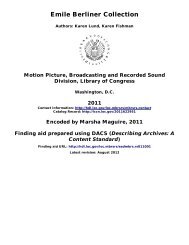
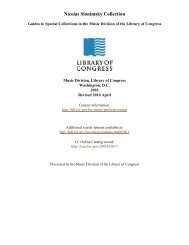
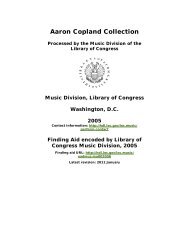

![Charles Tournemire Collection [finding aid]. Library of Congress ...](https://img.yumpu.com/50430648/1/190x245/charles-tournemire-collection-finding-aid-library-of-congress-.jpg?quality=85)
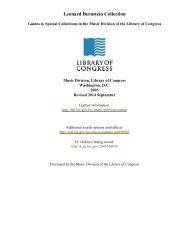
![Jerome Kern Collection [finding aid]. Library of Congress. [PDF ...](https://img.yumpu.com/49059084/1/190x245/jerome-kern-collection-finding-aid-library-of-congress-pdf-.jpg?quality=85)
![Gilbert Miller Collection [finding aid]. Library of Congress. [PDF ...](https://img.yumpu.com/48161025/1/190x245/gilbert-miller-collection-finding-aid-library-of-congress-pdf-.jpg?quality=85)
![Laurence Picken Papers [finding aid]. Library of Congress. [PDF ...](https://img.yumpu.com/47582767/1/190x245/laurence-picken-papers-finding-aid-library-of-congress-pdf-.jpg?quality=85)
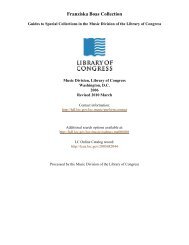
![William B. Bradbury Collection [finding aid]. Library of Congress ...](https://img.yumpu.com/45984228/1/190x245/william-b-bradbury-collection-finding-aid-library-of-congress-.jpg?quality=85)
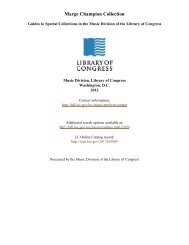
![Fritz Kreisler Collection [finding aid]. Library of Congress. [PDF ...](https://img.yumpu.com/43985867/1/190x245/fritz-kreisler-collection-finding-aid-library-of-congress-pdf-.jpg?quality=85)
![Edward Jablonski Papers [finding aid]. Library of Congress. [PDF ...](https://img.yumpu.com/43400820/1/190x245/edward-jablonski-papers-finding-aid-library-of-congress-pdf-.jpg?quality=85)